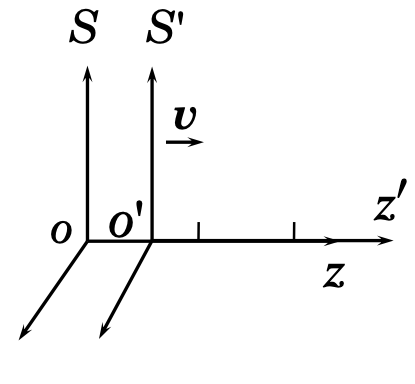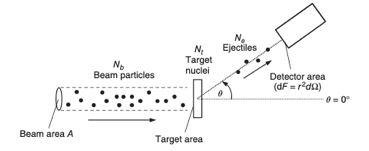Relativistic Kinetics¶
Mechanics in special relativity¶
This section explores the Lorentz transformation, relativistic energy and momentum, natural units, and the powerful formalism of 4-vectors, providing a cohesive framework for analyzing physical systems moving at relativistic speeds.
Lorentz transformation¶
In special relativity, space and time coordinates depend on the observer’s inertial frame of reference. Consider two inertial frames: one at rest (S) and another moving at velocity ( v ) along the +z-axis relative to it (S'). The Lorentz Transformation (LT) relates the coordinates (ct, x, y, z) in the rest frame to (ct', x', y', z') in the moving frame as follows:

where:
- $β=v/c$, with ( c ) as the speed of light,
- $γ=1/1−β^2$, the Lorentz factor.
Key properties of the LT include: Invariance of the spacetime interval:
The quantity $s^2 = (ct)^2 - x^2 - y^2 - z^2$ remains constant across all inertial frames, reflecting the fundamental structure of spacetime in special relativity.
Transverse lengths unchanged: Coordinates perpendicular to the direction of motion ( x ) and ( y ) are unaffected.
Length contraction: Along the direction of motion, the length of an object in the moving frame ($\Delta z'$) relates to its proper length (at rest, $\Delta z$) as $\Delta z' = \Delta z / \gamma$, meaning a moving object appears shorter.
Time dilation: The measured time interval of a moving clock is related to the elapsed time at rest (primed frame) by Δt‘ = γ Δt , i.e. time dilation. We call a time interval for an object at rest the “proper time” τ. Thus t‘ = γτ and t’ ≥ τ . The proper time concept is useful when comparing the lifetime of a particle in its rest frame and in the frame in which it is moving.
Relativistic energy and momentum¶
Relativistic mechanics extends classical definitions of momentum and energy to account for high velocities. For a particle with velocity $v$:
Momentum: $p = \gamma m v$, where $m$ is the rest mass.
Total energy: $E = \gamma m c^2$, encompassing both rest energy $m c^2$ and kinetic energy.
In the same coordinate frames as the LT, the energy-momentum transformations mirror the spacetime ones:
$$ \begin{align} &p'_x = p_x &p_x =& p'_x \\ &p'_y = p_y &p_y = &p'_y\\ &p'_z = γ (p_z − βE/c) &p_z =& γ (p'_z + βE/c)\\ &E'/c = γ (E/c − βp_z) &E/c =& γ (E'/c + βp_z) \end{align} $$Key relationships include:
Invariant mass: The quantity $(E/c)^2 - p_x^2 - p_y^2 - p_z^2 = m^2 c^2$ is preserved under LT, defining the rest mass $m$ as an invariant property.
Momentum magnitude: $p = \gamma \beta m c$.
Kinetic energy: $E_K = E - m c^2 = (\gamma - 1) m c^2$.
Energy-momentum relation: $E^2 = (p c)^2 + (m c^2)^2$, linking energy, momentum, and rest mass.
Mentum-Kinetic energy relation: $(pc)^2 = E_k^2+2mc^2E_K$
For massless particles (e.g., photons), $m = 0$, so $E = p c$, and their speed is always $c$. For highly relativistic particles ($E \gg m c^2$), $E \approx p c$ and $v \approx c$, resembling massless behavior.
Natural units¶
In relativistic kinematics, natural units simplify calculations by setting $c = 1$, expressing energy, momentum, and mass in GeV .
Key relationships in natural units:
Invariant mass: $E^2 - p_x^2 - p_y^2 - p_z^2 = m^2 $
Momentum magnitude: $p = \gamma \beta m$.
Kinetic energy: $E_K = E - m = (\gamma - 1) m$.
Energy-momentum relation: $E^2 = p^2 + m^2$.
Kinetic Energy-momentum relation: $p^2 = E_k^2+2mE_K$
Published literature often uses GeV/$c^2$ for mass and GeV/$c$ for momentum to retain dimensional clarity in SI units, but in natural units, these factors of $c$ are omitted. Conversions to SI units require GeV = 1.602 $\times 10^{-10} \, J$ and $c = 3 \times 10^8 \, m/s$ .
Example¶
Consider a $K_s$(K-short) meson with rest mass $m_{Ks} = 0.4977$ GeV moving along the +z-axis at $v = 0.95c$ in natural units:
$γ_{Ks} =1/\sqrt{1−0.95^2} = 3.202563$
$E_{Ks} =γ_{Ks} m_{Ks}=3.202563×0.4977 = 1.593916 \text{ GeV}$
$p_{z_{Ks}} =γ_{Ks}\beta_{Ks}m_{Ks} =3.202563×0.4977×0.95 = 1.514220 \text{ GeV}$, with $p_x=p_y=0$
Check invariance: $m = \sqrt{E^2 - p^2} = \sqrt{(1.593916)^2 - (1.514220)^2} = 0.4977$ GeV , matching the rest mass. In SI units, mass is $0.4977$ GeV/$c^2$, momentum is $1.514220$ GeV/$c$, convertible using standard constants. This example highlights the $K_s$ meson’s relativistic nature, with $E \approx 3m c^2$, approaching massless-like behavior $E \approx p$.
Vectors and Lorentz Transformations¶
The 4-vector formalism unifies spacetime and energy-momentum, streamlining relativistic analysis.
Definition of 4-Vectors¶
A 4-vector combines a time like component with a spatial 3-vector:
Spacetime 4-vector: $X = (ct, \vec{x}) = (ct, x, y, z)$,
Energy-momentum 4-vector: $P = (E/c, \vec{p}) = (E/c, p_x, p_y, p_z)$
.
For any 4-vector $A = (A_0, \vec{A})$, the 3-vector magnitude is $|\vec{A}|^2 = A_1^2 + A_2^2 + A_3^2$.
Lorentz Transformation of 4-Vectors¶
The LT applies to 4-vectors, preserving their inner product:
Inner product: $A \cdot B = A_0 B_0 - \vec{A} \cdot \vec{B} = A_0 B_0 - A_1 B_1 - A_2 B_2 - A_3 B_3$,
Norm: $A^2 = A \cdot A = A_0^2 - |\vec{A}|^2$
, invariant across frames.
For P:
- $P \cdot P = (E/c)^2 - |\vec{p}|^2 = m^2 c^2$, $P^2 = E^2 - p^2 = m^2$ in natural units, .
In the rest frame: $P = (m, 0, 0, 0)$, so $P^2 = m^2$, consistent in all frames.
Linear combinations of 4-vectors (e.g., $C = aA + bB$) are also 4-vectors, making this a versatile tool.
Multi-Particle Systems¶
For a system of particles, the total 4-momentum $P_{\text{total}} = \sum P_i$ has an invariant norm: $$ P_{\text{total}}^2 = \left( \sum E_i \right)^2 - \left| \sum \vec{p}_i \right|^2 $$ useful in decay or collision processes.
Conservation in Reactions¶
In a decay $P \to P_1 + P_2 + P_3$ or scattering $P_1 + P_2 \to P_3 + P_4$, 4-momentum conservation $P_{\text{initial}} = P_{\text{final}}$ automatically enforces both energy and momentum conservation, simplifying analysis.


